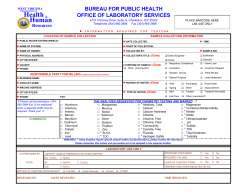
Ch 4 Aq Rxns 3
Precipitation Reactions Graphic: Wikimedia Commons User Tubifex Double Replacement Reactions The ions of two compounds exchange places in an aqueous solution to form two new compounds. AX + BY AY + BX One of the compounds formed is usually a precipitate (an insoluble solid), an insoluble gas that bubbles out of solution, or a molecular compound, usually water. Precipitates • • • Soluble – solid dissolves in solution; (aq) is used in reaction. Insoluble – solid does not dissolve in solution; (s) is used in reaction. Insoluble and slightly soluble are often used interchangeably. Copyright © Cengage Learning. All rights 3 Solubility Rules – AP Chemistry All sodium, potassium, ammonium, and nitrate salts are soluble in water. Solubility Rules – Mostly Soluble Ion NO3- Solubility Soluble Exceptions None ClO4- Soluble None Na+ Soluble None K+ Soluble None NH4+ Soluble None Cl-, I- Soluble Pb2+, Ag+, Hg22+ SO42- Soluble Ca2+, Ba2+, Sr2+, Pb2+, Ag+, Hg2+ Solubility Rules – Mostly Insoluble Ion CO32- Solubility Insoluble Exceptions Group IA and NH4+ PO43- Insoluble Group IA and NH4+ OH- Insoluble Group IA and Ca2+, Ba2+, Sr2+ S2- Insoluble Groups IA, IIA, and NH4+ Double replacement forming a precipitate… Lead(II) nitrate + potassium iodide lead(II) iodide + potassium nitrate Double replacement (ionic) equation Pb(NO3)2(aq) + 2KI(aq) PbI2(s) + 2KNO3(aq) Complete ionic equation shows compounds as aqueous ions Pb2+(aq) + 2 NO3-(aq) + 2 K+(aq) +2 I-(aq) PbI2(s) + 2K+(aq) + 2 NO3-(aq) Net ionic equation eliminates the spectator ions Pb2+(aq) + 2 I-(aq) PbI2(s) The Reaction of K2CrO4(aq) and Ba(NO3)2(aq) Ba(NO3)2 (aq) + K2CrO4(aq) → BaCrO4(s) + KNO3 (aq) Copyright © Cengage Learning. All rights 8 Formula Equation (Molecular Equation) • • • Gives the overall reaction stoichiometry but not necessarily the actual forms of the reactants and products in solution. Reactants and products generally shown as compounds. Use solubility rules to determine which compounds are aqueous and which compounds are solids. AgNO3(aq) + NaCl(aq) AgCl(s) + NaNO3(aq) Copyright © Cengage Learning. All rights 9 Complete Ionic Equation • Represents as ions all reactants and products that are strong electrolytes. Ag+(aq) + NO3(aq) + Na+(aq) + Cl(aq) AgCl(s) + Na+(aq) + NO3(aq) Copyright © Cengage Learning. All rights 10 Net Ionic Equation • Includes only those solution components undergoing a change. Show only components that actually react. Ag+(aq) + Cl(aq) AgCl(s) • Spectator ions are not included (ions that do not participate directly in the reaction). Na+ and NO3 are spectator ions. Copyright © Cengage Learning. All rights 11 Solving Stoichiometry Problems for Reactions in Solution Identify the species present in the combined solution, and determine what reaction if any occurs. Write balanced net ionic equation for the reaction. Calculate moles of reactants. Determine which reactant is limiting. Calculate moles of product(s), as required. Convert to grams or other units, as required. Example: 10.0 mL of 0.25M Barium chloride is reacted with 10.0mL of 0.35M sodium sulfate. Write the balanced reaction How many grams of ppt will form? Example: 50.0mL of 0.10M sodium phosphate is mixed with 50.0mL of 0.10M copper II chloride. Write the balanced reaction How many grams of ppt will form? Example 10.0 mL of a 0.30 M sodium phosphate solution reacts with 20.0 mL of a 0.20 M lead(II) nitrate solution (assume no volume change). What precipitate will form? What mass of precipitate will form? 1.1 g Pb3(PO4)2 20 Let’s Think About It • Where are we going? • To find the mass of solid Pb3(PO4)2 formed. How do we get there? What are the ions present in the combined solution? What is the balanced net ionic equation for the reaction? What are the moles of reactants present in the solution? Which reactant is limiting? What moles of Pb3(PO4)2 will be formed? What mass of Pb3(PO4)2 will be formed? 21 Example 5 10.0 mL of a 0.30 M sodium phosphate solution reacts with 20.0 mL of a 0.20 M lead(II) nitrate solution (assume no volume change). What is the concentration of nitrate ions left in solution after the reaction is complete? 0.27 M 22 Let’s Think About It • • Where are we going? To find the concentration of nitrate ions left in solution after the reaction is complete. How do we get there? What are the moles of nitrate ions present in the combined solution? What is the total volume of the combined solution? 23 Example 6 10.0 mL of a 0.30 M sodium phosphate solution reacts with 20.0 mL of a 0.20 M lead(II) nitrate solution (assume no volume change). What is the concentration of phosphate ions left in solution after the reaction is complete? 0.011 M 24 Let’s Think About It • • Where are we going? To find the concentration of phosphate ions left in solution after the reaction is complete. How do we get there? What are the moles of phosphate ions present in the solution at the start of the reaction? How many moles of phosphate ions were used up in the reaction to make the solid Pb3(PO4)2? How many moles of phosphate ions are left over after the reaction is complete? What is the total volume of the combined solution? 25 10.0 mL of a 0.30 M sodium phosphate solution reacts with 20.0 mL of a 0.20 M lead(II) nitrate solution (assume no volume change). What is the concentration of nitrate ions left in solution after the reaction is complete?
© Copyright 2025













